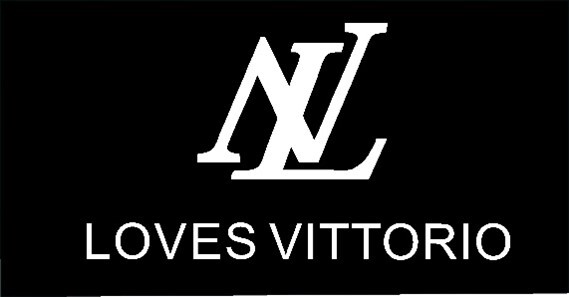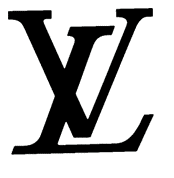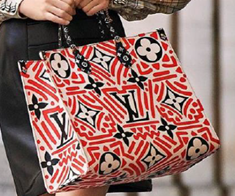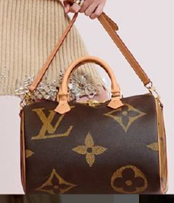Louis Vuitton Successfully Cancels Competing ‘Loves Vittorio’ Trade Mark

Knocking out the knock offs! Louis Vuitton recently successfully invalidated a highly similar EU trade mark application for ‘Loves Vittorio.’ Our Intellectual Property team explores how brand owners can successfully avoid issues with knock-off brands.
We examined in a previous article an EU General Court decision in a case involving Louis Vuitton’s famous ‘Damier Azur’ pattern. Now, the French luxury fashion house has again been in the trade mark wars. In a recent EUIPO decision, Louis Vuitton successfully invalidated a competing trade mark for ‘Loves Vittorio’ despite having unsuccessfully opposed the same mark. We consider the decision and the key takeaways for brand owners in the fashion sector.
An individual named Aina Yang based in Rome, Italy, filed an EU trade mark (EUTM) application in September 2020. The application was sought for the below sign to protect amongst other clothing-related goods, “Clothing” and “Footwear” in Class 25 and “Accessories for apparel” in Class 26.

Louis Vuitton filed an opposition in November 2020 in which it argued that there was a likelihood of confusion with its pre-existing registrations for the below mark.

In a decision dated 14 January 2022, the EUIPO rejected Louis Vuitton’s opposition because of the very low degree of visual and aural similarity between the signs. Louis Vuitton had not submitted evidence of reputation of its trade mark in the opposition proceedings, something which is important as seen in the Big Mac case. The ‘Loves Vittorio’ mark subsequently proceeded to registration in April 2022 and in November 2022, Louis Vuitton filed an invalidity application. The invalidity application was based on two EUTM registrations and a French national registration, all for the Louis Vuitton mark above. Louis Vuitton again argued that there was a likelihood of confusion and that the ‘Loves Vittorio’ registration infringed its rights to a mark with a reputation.
EUIPO decision
Res judicata
The EUTM owner argued that the invalidity application should be rejected outright pursuant to Article 63(3) EUTMR. This provision states that an invalidity application is inadmissible where an application relating to the same subject matter and cause of action, and involving the same parties, has already been adjudicated on its merits by the Office. The EUIPO Cancellation Division rejected this argument. Although the parties were the same and the same marks were involved, no facts, arguments or evidence concerning the reputation of the trade marks on which the opposition was based, were submitted in the opposition proceedings. For that reason, the cause of action was different in the invalidity proceedings.
Genuine use
The EUTM owner required that Louis Vuitton show evidence of use of its marks in the EU. In response, Louis Vuitton submitted a large volume of documents including invoices demonstrating sales in its shops in France, Italy, Spain and Germany. Some examples of use submitted include the images below.



From these examples, the EUIPO Cancellation Division was satisfied that the Louis Vuitton registrations were not lost in the overall impression produced by the various elements of the pattern, “but can be perceived separately.” For that reason, Louis Vuitton had demonstrated genuine use for at least “Trunks, travelling bags, bags” and “handbags” in Class 18 and “Clothing articles for women” in Class 25.
Reputation
The EUIPO was satisfied that the evidence submitted by Louis Vuitton proved that it was founded in 1854 and is currently one of the world’s largest luxury goods companies. It was also satisfied that the Louis Vuitton mark relied on ‘enjoys reputation’ for goods in Classes 18 and 25.
Link between the trade marks
The EUIPO was satisfied that the competing marks were visually and aurally similar to at least, a very low degree. They were both seeking protection for clothing related goods in Class 25 which serve the same purpose. In addition, the competing goods “clothing articles for women” and “clothing, footwear and headwear” were articles of fashion and are often found in the same retail outlets. The EUIPO therefore concluded that relevant consumers would likely associate the ‘Loves Vittorio’ mark with the Louis Vuitton mark and would establish a mental link between the marks.
Unfair advantage (free-riding)
The EUIPO agreed with Louis Vuitton that the use of the ‘Loves Vittorio’ mark will, due to its similarity with the Louis Vuitton mark, attract more customers to the owners goods. It would benefit from Louis Vuitton’s reputation with the consequence that “a substantial number of customers may decide to turn to the EUTM proprietor’s goods due to the mental association” with the Louis Vuitton registrations. This would result in “misappropriating its powers of attraction and advertising value.” This could stimulate sales of the EUTM owners goods so that they are disproportionately high in comparison with their own promotional investment. This would lead to the “unacceptable situation”, according to the EUIPO, where the EUTM owner is permitted to take a “free-ride” on Louis Vuitton’s investment in promoting and building up goodwill for the EUTM owners sign.
Due cause
Finally, the EUTM owner claimed to have ‘due cause’ for use of the ‘Loves Vittorio’ mark because:
- A search of the EU registers did not reveal any identical or similar marks, and
- The name of the famous Italian Piazza Vittorio was the inspiration for the name ‘Vittorio.’
The EUTM owner wished to dedicate her brand to Italianism, to Rome and to the place where she lives with her family. The EUIPO held that these arguments do not amount to ‘due cause’ within the meaning of Article 8(5) EUTMR.
Comment
Louis Vuitton was ultimately successful and the ‘Loves Vittorio’ mark has now been invalidated. The decision will be viewed as a win for trade mark owners and companies who are trying to combat knock-off brands. It also demonstrates that brand owners can potentially have two bites of the cherry. It shows the value of relying on the reputation of a well-known trade mark and not just relying on the likelihood of confusion, which was the approach initially adopted by Louis Vuitton in the opposition proceedings. To avoid issues arising with copycat and knock-off brands, trade mark owners should consider the following:
- Putting in place appropriate watching services for ‘look-alike’ and highly similar marks being filed.
- Taking action quickly and decisively when ‘look-alike’ marks appear. This will help prevent competitors from gaining additional unregistered rights and will also help prevent subsequent arguments arising around honest concurrent use.
- Keeping up-to-date records and examples of the use of registered trade marks so that these are easily accessible, if needed. This will assist with both enforcement against ‘look-alike’ marks and with defending registrations against non-use actions filed by third parties.
For more information and expert advice, contact a member of our Intellectual Property team.
The content of this article is provided for information purposes only and does not constitute legal or other advice.
Share this:



